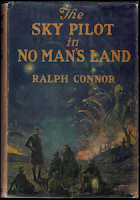Emily Joyce Boyle was born on April 6, 1901, missing that year's census by a matter of days. The 1911 census finds Joyce as a ten-year-old living at 227 Westminster Avenue in Toronto with her mother Charlotte and three surviving siblings (Gertrude, John, and Beatrice). Her father, William, recorded in previous censuses as lumber merchant and a crockery merchant, died when she was a four-year-old.
At the time of the 1921 census, Joyce was still living on Westminster Avenue with her mother, Gertrude, and Beatrice. Interestingly, all four Boyle women are reported as having no occupation. They were certainly not members of the leisure class, yet the family appears to have had the means to send Beatrice and Joyce off to the University of Toronto.
The photo of Joyce Boyle featured above, the only one I've found, comes from the 1924 edition of Torontonesis, the university's student annual. These are the words that appear below:
In the 1931 census, thirty-year-old Joyce and forty-six-year-old sister Gertrude are listed as living at 307 Castlefield Avenue in Toronto. Joyce's occupation is school teacher, while Gertrude's is school librarian.
 |
| 307 Castlefield Avenue in June 2021 |
The previous year, Joyce had published Mary, John and Peter, which is most likely her first book.
 |
| Toronto: T. Eaton, 1930 |
Intriguingly, Joyce Boyle's entry in the Database of Canada's Early Women Writers notes that McMaster University's Macmillan Company of Canada Archives contains correspondence regarding an earlier work, Spring Blew Around the Corner, of which there is no known copy. Was it ever published? Thus far, I've found no reviews, adverts or even passing mentions in newspapers and magazines.
She's credited with eleven other titles, most of which – Mary, John and Peter being one – are schoolbooks meant for young children. Of those that aren't, the one that garnered the greatest attention was Muskoka Holiday, a 1953 girls' adventure novel published by Macmillan in Canada, England, and the United States.
Muskoka Holiday has my favourite cover by far, though Bobby's Neighbors has a certain lazy charm.
 |
| Nashville: Abingdon, 1959 |
Joyce Boyle died at the age of seventy-four on June 7, 1975, at Women's College Hospital in Toronto. She was predeceased by all of her siblings (including previously unmentioned Ernest, who died on the date of his birth, and Edith, who died at eleven). The University of Toronto's Joyce Boyle Scholarship is awarded to "a student with overall A standing who is enrolled in the Specialist or Major program in English, with preference to a student whose courses have included romantic poetry or prose." It was established by brother-in-law Stephen James Mathers (1896-1985), who was married to Joyce's sister Beatrice (1899-1969). Mathers also established a scholarship in honour of his late wife.
A good man.
From all I've been able to glean from newspaper articles, Joyce Boyle was a woman who dedicated her life to children's education. She was particularly focussed in fostering early interest in literature and the cause of world peace.
A good woman.



















































